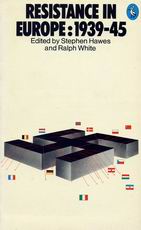

|
|

Resistance in Europe: 1939 - 45
Hawes, Stephen; White, Ralph; (eds)
Publisher: Penguin Books, Markham, CanadaYear First Published: 1975 Year Published: 1976 Pages: 234pp ISBN: 0-1402.1817-3 Resource Type: Book Cx Number: CX7613 Essays on the resistance against Hitler during World War II. Abstract: Resistance in Europe is a collection of ten essays on the resistance against Hitler during World War II. The various contributors aim to complete a picture of this resistance. The picture is short in scope of time and location, focusing only on World War II in the years between 1939-1945 and on those countries that endured Nazi occupation, but it is in-depth and fairly conclusive. Each contributor looked at a different aspect of the resistance movement, such as the strategic, political and social implications. The study is conducted through many different sets of eyes to construct an multi-faceted report. The ideologies of the time are a focus of the book as several historians and activists describe the relationship between individual resistance and unified movement. Ralph White ties the essays together with a claim about the diversity of the movement. In his introduction and his essay "The Unity and Diversity of European Resistance," he analyzes the different types of resistance and their role as parts of a whole. This sets the framework for the other nine essays. These range in topic from de-glorifying the war, to the military effectiveness of the resistance, and to the ideas in and outside of Germany. Some contributors use the first-hand accounts of surviving interest groups, while others support their findings with research and statistics. The book as a whole is informative and well-sourced. In conclusion, the book claims that although the resistance to Hitler was not strategically powerful, it was a great and successful effort. It should not be described passionately or romantically, but a cool look at the factors can provide a closer look at the resistance of the past to secure a movement for the future. [Abstract by Mia Manns] Table of Contents Introduction 1. The Unity and Diversity of European Resistance 2. Agents, Resisters and the Local Population 3. The Underground Movement in Auschwitz Concentration Camp 4. Resistance and the Catholic Church in France 5. Behind the Polemics: French Communists and Resistance 1939-41 6. The Individual and the Resistance Community in France 7. Resistance and Opposition amongst Germans 8. The German Counter-Resistance 9. The Economic and Strategic Effectiveness of Resistance 10. What Good Did Resistance Do? Conclusion Bibliography Subject Headings
|